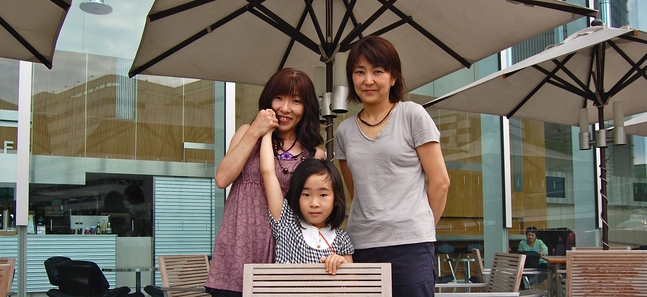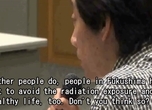Yokohama mums against radiation
The fight to remove contaminated food from the school menu

Mothers against radiation: (L to R) Toshiko Yasuda, her daughter, and a protestor in arms
Posted: Mon Aug 29 2011
Late last week, the Japanese government lifted a ban on shipments of beef from Fukushima, Iwate and Tochigi Prefectures, bringing minor relief to farmers whose livelihoods had been threatened by the discovery in late July that over 4,000 kilograms of cesium-contaminated beef had hit the shelves at Aeon, one of Japan's biggest supermarkets. Not that the pressure has been entirely lifted, of course. Amongst everyday folk as much as the farmers themselves, confusion is rife.
Unsurprisingly, few can tell a becquerel from a sievert, and plenty feel that this lack of knowledge has allowed the government and nuclear industry to patronise and mislead them. Couple that with the perception that the country's leaders have no real idea themselves (Japan just lost its sixth prime minister in five years in a mess of backstabbing and ineptitude), and the current sense of mistrust is wholly justifiable.
For Toshiko Yasuda, a housewife from Yokohama, the only way forward has been to take action herself. Like many others, she watched the explosions at Fukushima Daiichi from the apparent safety of her home, 260 kilometres southwest of the reactors. 'At first, I was scared,' she recalls. 'I couldn't let my little girl out of the house. During the spring break, she didn't go outside once.' Her response, she quickly realised, was ill-informed. 'It was wrong of me to let my imagination take control of my actions, so I focused on learning the facts.'
Admitting that she knew next to nothing, Toshiko began studying all she could about the Chernobyl incident, and about the known effects of radiation on the human body, expending as much effort as possible on balancing fact against hearsay. It quickly became clear that external radiation probably had very little effect on daily life in Yokohama. The question that she continued to come up against, however, concerned internal radiation. With Fukushima produce freely available in the local supermarket, how could she protect herself and her family against that?
While this was relatively easy to do at home, where she bought produce from as far west as possible, Toshiko had her doubts about what her young daughter was being fed at the local elementary school. Surely counter measures had been employed to ensure the kids weren't eating contaminated produce? To her horror, no such efforts were being made.
'They told us they had no plans to change how they prepared the meals,' she says, the smirk of disbelief still there on her lips; 'that the products they used were "distributed in the market, therefore they're safe".'
In late March, as the rest of the country reacted to the disasters and rumours with understandable incredulity, Toshiko took it upon herself to act. 'I went to the school and questioned them about the origin of the products they were using,' she explains. 'I demanded they use products from as far west as possible, but they told me there was nothing the school could do. "All right then," I said,' and she laughs here at the memory. '"You people obviously aren't who I need to be speaking to. I'll go to the Board of Education."'
To be fair to the school, it's easy to see how Toshiko could be mistaken at this point for a pushy, slightly deranged character – a lone mother on a mission, apparently armed with little more than pop science and personal conviction. She says she was fully aware of how she appeared. 'I couldn't just take on the Board of Education alone like this,' she reflects. 'I knew I'd be seen as an oversensitive mother, so I came up with the idea of starting a petition. I made a flyer containing all the information I could get my hands on. That was April 20.'
The petition that she eventually submitted contained 2,500 signatures. However, it was rejected – by the school, the assembly, and eventually the Mayor of Yokohama. Toshiko had come to a crossroads. 'I thought, do I stop here or do I not give up and continue this mission?' With the support of the people that had been involved in the petition, she decided to form Yokohama no Kodomotachi wo Hoshano kara Mamorukai ('Group to Protect the Children of Yokohama from Radiation'), with the aim of spreading the word and exerting continued pressure on the local government. At the time of writing, the group has around 700 members – 'some fathers,' notes Toshiko, 'but mostly mothers'.
Back on the home front, of course, she had a decision to make. Now convinced that the food her daughter was being fed was likely to contain radioactive materials, there was no way she could allow her to continue eating it. Taking her off the school dinners register, she began sending her to school with a homemade bento lunchbox. So as not to make the child feel out of place, she was careful to prepare food that was similar to the school's daily menu, something she is still doing almost five months on.
'On the first day she took her bento, everyone made fun of her,' she says. 'I expected that would happen, so I started making the lunches entertaining by introducing "kyara ben" [bentos decorated to look like famous manga and anime characters]. Other kids love them now, too, so my daughter is happy. You see, kids are simple. It's up to us adults to use our knowledge to solve their little problems.'
While some parents followed suit, many saw little reason to change their children's diets. After all, what reason did they have not to trust what the school was telling them? For Toshiko, it was obvious that an itemized menu was needed: something to show exactly where the produce was coming from.
Weeks before the Aeon beef announcement, she received a tip-off from a politician who supported her group, telling her that Fukushima beef was being used in school meals. 'At around the same time, more and more Yokohama residents began asking questions, demanding that all food products should be labeled with the place of growth or production. As a result, the School Meals Committee began publishing product information. When people saw the list of ingredients, there was an uproar.' The publication, which Toshiko received in May, showed that the school meals had contained cabbage, asparagus, beef, beans and cucumbers from Fukushima.
Yet this publication altered nothing. Toshiko explains, 'The Board of Education and the School Meals Committee said that, because they had always used Fukushima produce in school meals, they had no intention of stopping now.' Their reasons, she says, were purely financial, citing the economic damage that the Fukushima region could suffer if they altered their policy. Indeed, she has been shocked to hear of families feeding their children Fukushima produce out of similar concerns. 'One of my friends had been spreading the word, and she was cornered by a mother who said that we should willingly buy produce from Fukushima to help the industries there. She was deliberately feeding it to her kids.'
'I think it's an awful national habit that we Japanese have,' she continues. 'During the war, Japanese people would willingly sacrifice themselves if it was beneficial for the country. That was the norm, the virtue.' She stops, wide-eyed again, as if she can't quite fathom what she's saying. 'That mentality lives on. The government has passed the buck to the people of Japan, saying, "Please eat the Fukushima vegetables. Poor Fukushima people. They need your help." Yes, of course we have to help the industries and economy of Fukushima, but is it okay for our children to eat that produce, get sick and die young? Should we let them develop cancer? That's a completely different argument.'
It should be noted that Toshiko and her group aren't purely critical in their outlook: she praises Yokohama for being the first city in the country to disclose information regarding the origins of produce. However, she still feels that things should go an extra step. 'The uncertainty is what made us anxious,' she explains. 'The Board of Education and the government alike often said that the fact that we parents worry so much has a negative effect on the physical and mental health of our children… But we just want to know what to do… We don't want the heartache of worrying about what we're feeding our kids.' Ideally, she said, she'd like to see the food labelled with radiation readings, so that parents could decide what to buy and what to avoid.
Of course, Toshiko's group aren't the only ones protesting the food situation. She knows of many others ('one in Sendai, Chiba has three, and there are Tokyo groups in Setagaya, Katsushika, Minato-ku, Koto-ku, Fuchu…'), and they each do what they can to support one another. Special mention is reserved for the groups that have been set up in Fukushima Prefecture itself: 'When I started the petition, I feared that I may hurt the feelings of people in the quake stricken regions. But in reality, there are still so many families living in Fukushima, crying their hearts out, wanting to leave even though they can’t. These people want people from other parts of Japan – Yokohama or wherever – to make an issue of the dangers of radiation, so everybody realises how dangerous Fukushima actually is. They plead with us to kick up a fuss: if we don’t speak out, we won’t be helping those in Fukushima. When they told me that, I realised I was doing the right thing.'
At the time of writing, her group were preparing a third petition to the Board of Education in Yokohama, a list of signatures that they hope will top 10,000. The petition, once again, calls for clarity: for evidence that the food being fed to the children of the city does not contain unusual levels of radiation. It's an astonishing request for any parent to have to make.
Read more about Toshiko's mission on the official homepage of Yokohama no Kodomotachi wo Hoshano kara Mamorukai
Tweets
- About Us |
- Work for Time Out |
- Send us info |
- Advertising |
- Mobile edition |
- Terms & Conditions |
- Privacy policy |
- Contact Us
Copyright © 2014 Time Out Tokyo














Add your comment